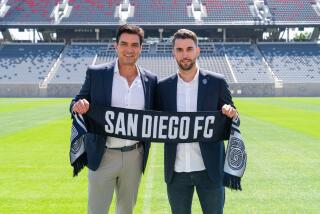Call It CompuScore : Software Program Allows Soccer Coaches to Map Out Game With More Precision
It was in Israel, more than 20 years ago, that the idea first occurred to Zvi Friedman.
While not quite a bolt out of the blue, it did come from above.
âI was doing air-to-air combat analysis,â Friedman recalled. âMy job was to interview pilots coming back from [simulated] combat.
âIt occurred to me, as a soccer enthusiast, that if we could make sense out of air-to-air combat, with maybe 20 or 30 airplanes fighting each other, and systematically come up with ways to improve it, why couldnât we do that in soccer?â
Flash forward a couple of decades and Friedman is no longer in Israel. Heâs in Canoga Park, working as an aeronautical and industrial engineer at Rocketdyne, where he meets Jonathan Kotas, a computer programmer.
âHe had zero knowledge of soccer,â said Friedman, who had been a player and coach.
âI said to him one evening, âJon, can you draw me a soccer field on the computer?â He said, âWhatâs it look like?â I told him, and the next morning he had it done.
âHe said, âHere it is. What are you going to do with it?â I said Iâd like to put data onto it. âWhat sort of data?â
âBefore I knew it, he had done it. Every day he came up with another thing. I was stunned.â
And thus was born what FIFA, world soccerâs governing body, has termed âthe second revolutionâ in the evaluation of the sport and what author and columnist Paul Gardner has called âa soccer bomb.â
The explosion has yet to occur.
*
Mexico and Colombia are playing each other in front of 45,000 at the Coliseum.
In the press box, two men are seated at laptop computers, but theyâre not writing. The screen shows a soccer field. The cursor is the ball. The keys have been covered by yellow and green stickers, each with a player number written on it.
Behind them, another two men keep binoculars trained on the field. They call out every pass.
âYellow 14, Yellow 9, Green 4, Green 7. . . . â
The computer operators tap the appropriate keys, simultaneously moving the mouse in the same way the ball is being played.
To them, it doesnât matter that âYellow 10â is Colombiaâs Carlos Valderrama, one of the worldâs top midfielders or that âGreen 2â is Mexican defender Claudio Suarez. To them, they are merely numbers.
By the end of 90 minutes, every play made in the game, every pass, every interception, every shot, has been entered into the computer. More than 3,500 âdata points,â as Friedman and Kotas refer to them, have been cataloged.
The two coaches, Mexicoâs Bora Milutinovic and Colombiaâs Hernan Dario Gomez, have watched the game and have their impression of what occurred.
The television cameras have recorded the action and the coaches later will review the game on tape. In the press box, Friedman and Kotas and the two associates they are training have an equally valuable resource.
They have the game in the computer.
And that means they can extract any information they want from the match almost instantly. Thereâs no need to rely on memory or to rewind the tape to search for a particular play. And they can get data that neither memory nor tape can provide.
Want to know how many shots Valderrama took and from where on the field and at what time in the game? Just tap a couple of keys. Want to know exactly how Mexicoâs second goal was scored? The computer will diagram it for you, going back as many passes as you want.
The software Friedman and Kotas have developed has the potential to be an invaluable tool for coaches worldwide and, in an equally pleasant thought for the two scientists, the potential to earn them millions.
Although still in its infancy, it already has proven its worth.
--Carlos Alberto Parreira used it while coaching Brazil to its World Cup â94 triumph.
--Milutinovic used it while coaching the United States to several memorable victories, including the upset of Colombia in the World Cup.
--Steve Sampson, Milutinovicâs successor as U.S. national team coach, used it helping the American team reach the semifinals of the Copa America tournament in Uruguay last summer.
Milutinovic and Sampson will use it during the CONCACAF Gold Cup that begins today.
Writing in FIFA Magazine in October, Andreas Herren, said: âThe world of opportunities that this program opens up is--since the introduction of video âpost-mortemsâ--tantamount to a second revolution in the evaluation of football matches. . . .â
Ron Newman, the most successful professional coach in U.S. history and now coach of Major League Soccerâs Kansas City Wiz, is a convert.
âI can see it being very advantageous for World Cup teams, when they prepare to the ultimate,â he said. âYouâve got plenty of time, plenty of staff, plenty of money. I think itâs a great idea for that.
âWhether it can be done on a club basis, where you play every week and teams change, and things like that, Iâm not sure. But I think thereâs something there. Iâm fascinated by it. I think it can tell you things that you may not have seen.â
MLS is interested in the concept and may pursue it.
Not so sure about all this is Gardner, who believes there is too much coaching going on already and worries about what he calls âthe artistic componentâ disappearing from the game.
âIn a way, Friedman has presented us with a soccer bomb,â Gardner wrote recently in Soccer America magazine. âHis work cannot be ignored. . . . It comes dressed up not only as a science, but as computer science. In this era, you donât argue with computers.
âSo where is Friedmanâs bomb leading us? Ultimately, in one of those Wellsian visions of a future scientific paradise, to the computer coach. . . . A computer that will consign coaches to the scrap heap as irrelevant, old-fashioned and unscientific.â
Gardnerâs main concern is that the computer is seeing only part of the picture, and not the most important part. âScience is all about measuring things,â he wrote. âYou cannot measure inspiration or creativity or excitement or pleasure or dribbling skill or timing . . . or genius. Some of us believe those elements matter in soccer.â
Unfazed by such criticism, Friedman, of West Hills, and Kotas, of Thousand Oaks, have their eyes focused on the future.
They can see their software developing into all sorts of areas--combining with video, animation, even virtual reality. And expanding in other ways too. âCan it be applied to other sports?â Friedman asked, repeating a question. âYes. In the near future.â
He comes back to the lessons he learned while working with pilots in Israel. âThe coach is coaching by the gut feeling, the pilot was flying by the gut feeling,â he said. âBut no more, because he was getting all kinds of information presented to him at the right time, in the right place, in the right format, so it can help him in making decisions. What is a coach doing? Making decisions.â
He disputes Gardnerâs purposely hyperbolic claim that coaches would become obsolete.
âYouâre never going to replace the coaches,â Friedman said. âThe reason is, you still have to analyze the game and make decisions. The only thing weâre doing is helping the coach get information visually. Adding to information he can get from video.â
Timo Liekoski, the senior assistant under Milutinovic on the U.S. World Cup â94 team and now coach of the Columbus Crew of MLS, acknowledges the increasing use of computers in soccer. Even FIFA, for example, now has its own Internet page on the World Wide Web (https://www.fifa.com/index:html) and some top clubs are becoming interested.
âI know that [former world club champion] Sao Paolo [of Brazil], for example, uses a computer extensively and even has a laptop on the bench,â he said.
But, like Gardner, Liekoski is resistant to the concept.
âIn the end, the game is played by the players on the field,â he said. âItâs not not like football or baseball where you can really get some objective measures [of player efficiency]. I donât think soccer works that way.â
Perhaps. But that will not stop Friedman and Kotas from pursuing their dream. To them, like those pilots 20 years ago, the skyâs the limit.
Gold Cup Notes
Gold Cup coaches are taking different approaches to the nine-nation tournament. U.S. Coach Steve Sampson will field his strongest team in an effort to regain the trophy the Americans won in 1991 with a victory over Honduras on penalty kicks in the final at the Coliseum. Ernesto Rosa Guades, the Honduran coach, will use that loss to motivate his team. El Salvador will be buoyed by having knocked Costa Rica out of the tournament in the final qualifying game. As a result, Sampson is likely to seek some information from El Salvador Coach Omar Pastoriza, since the U.S. team faces Costa Rica in World Cup â98 qualifying play in the fall.
Mexicoâs Bora Milutinovic will be under pressure to repeat the feat of his predecessor, Miguel Mejia Baron, who coached Mexico to a 4-0 victory over the U.S. team in the 1993 final before 120,000 at Azteca Stadium in Mexico City. Brazilâs Mario âLoboâ Zagalo has brought what is virtually a youth team to the tournament, with no player older than 23 and most only 20 or 21. The idea is to give the players international experience while preparing them for the Atlanta Olympics in July. Goalkeeper Dida and forward Caio were on the Brazilian team that won the FIFA under-20 world championship in Australia in 1993.






